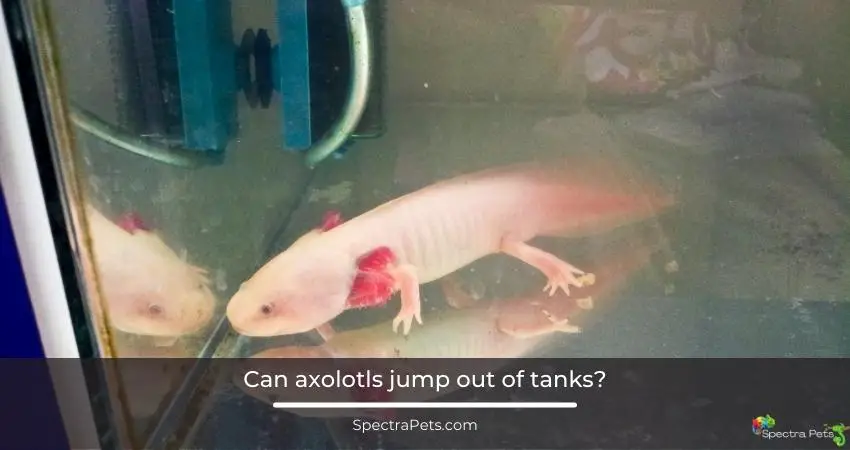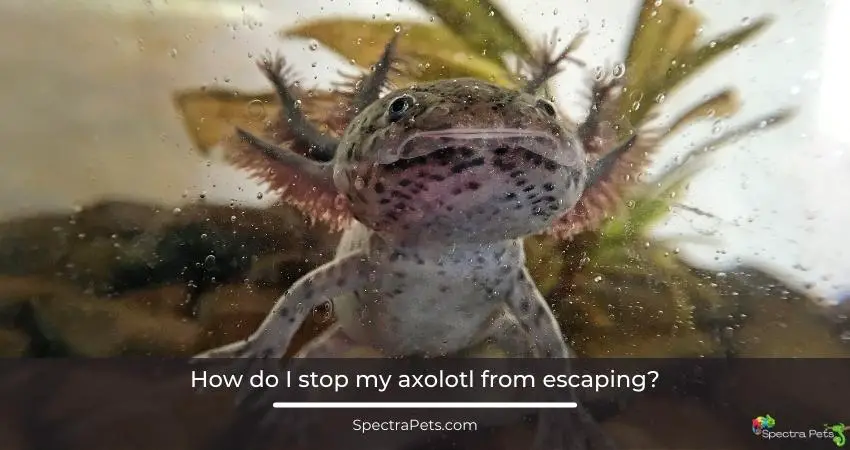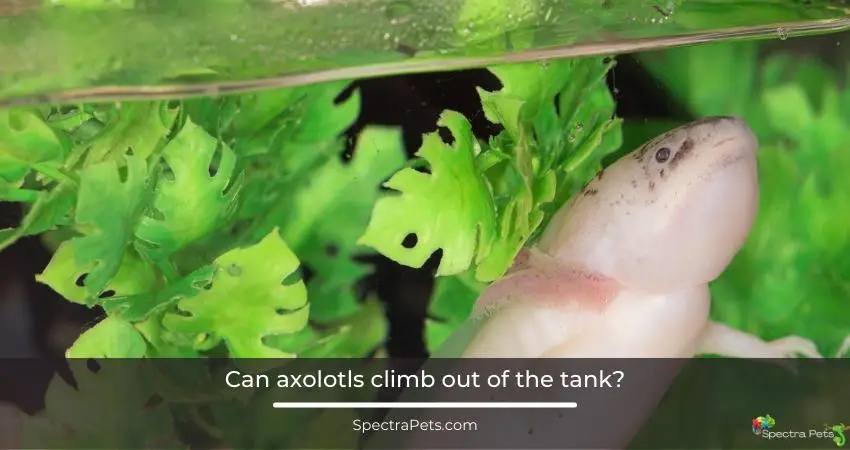Embarking on the journey of pet ownership goes beyond simply providing food and shelter; it requires a deep understanding of your pet’s behaviors, particularly when it comes to exotic creatures like axolotls. These enigmatic amphibians, closely related to frogs and toads, often spark a pressing question among pet owners: Can axolotls actually jump out of their tanks?
Surprisingly, axolotls are indeed capable of leaping out of their tanks, despite their seemingly delicate legs. Various factors can trigger this unexpected behavior, from suboptimal tank conditions to stress or even an inherently active axolotl.
Join us as we unravel the mysteries behind these remarkable creatures and uncover the reasons why axolotls might jump out of their tanks.

Why does my axolotl jump out of the tank?
Axolotls are not as common as pets as frogs, toads, and salamanders. That is why a lot of pet owners don’t know about their behavior, which makes it harder for them to keep the animal as a pet. One such behavior is the axolotls jumping out of the tank. Unaware pet owners sometimes find their pet axolotls out of their tank, and wonder, “Why do my axolotls get out of the tank?”
Well, there could be a lot of reasons why your axolotls might jump out of their tanks. They are:
1. Tank conditions
Axolotls need their tanks to be dimly lit with a few places to hide and rest. If you put intensely bright lighting in your pet axolotl’s tank with no place for it to get away from the light, the animal will be compelled to jump.
Another tank condition that can tempt an axolotl to escape is if the tank is too small for the animal. Adult axolotls need a tank of at least 20 gallons. If the tank size is not large enough for the animal, it will not want to stay in the tank and will want to jump out of it.
2. Water conditions
Axolotls are pretty sensitive to changes in their desired water conditions. They need the water temperatures to be between 15 and 18 degrees Celsius. If the water temperature is higher than 18 degrees Celsius, the tank will be too warm for the axolotl to live in, and they will jump out of the tank.
Apart from the temperature, the pH levels of the tank water have to be between 7.4 to 7.6, which means the water has to be pretty neutral. If the water is too basic or too acidic, the axolotl will try to escape the first chance it gets.
Still or slow-moving water is what axolotls enjoy most. If you install a pump or filter that moves the water too fast and violently, the water will be uninhabitable for the axolotl. As a result, it will try to escape the tank.
3. Stress
Axolotls get stressed easily, especially if they are housed with other animals. Even other axolotls can sometimes stress an axolotl. If the tank size is not enough for multiple axolotls, they will start competing for food and territory. The less dominant axolotls will then start to lose the competition and want to escape the tank.
Keeping axolotls with fish is also a bad idea. There are a couple of reasons for this. First, fish tend to annoy axolotls too much by nibbling at their feet, gills, and other body parts for them to live in the same tank as them. Second, most fish like fast-moving, warm waters in their tanks. This is exactly opposite to the water requirements for axolotls.
So if you keep axolotls with fish in the same tank, the amphibians will get stressed and will want to jump out of the tank as soon as possible.
4. Scared or Surprised
Sometimes the axolotls’ act of jumping out of their tanks is a reaction to them being scared or surprised. If you suddenly come at your axolotl and invade their personal space, they will be easily scared and will tend to jump out of their tanks.
5. A hyperactive animal
Sometimes you do everything possible to make the tank and water conditions of your axolotl tank as best as possible, but still, you see the animals jumping out of their tanks. Then the only explanation for this behavior would be that the animal you own is hyperactive and just want to escape for no other apparent reason.
6. No tank lids
Even if your axolotl’s water and tank conditions are not great or they are stressed, they still would not have been able to get out of their tanks if the tank had a lid or a top. Open tanks are an invitation for axolotls to jump out at the slightest inconvenience.
How do I stop my axolotl from escaping?

Now that you know why your axolotls might keep jumping out of their tanks, it’s time for you to know how you can stop it from happening. Here are the ways you can ensure your axolotl remains inside its tank:
1. Ensuring the tank conditions are met
First, you have to make sure the tank condition of your axolotl is perfect for it to live in. Make sure the tank’s size is at least 20 gallons if you have only one axolotl in it. Also, make sure to install low-intensity lighting in the tank so that the animal is not bothered by it. Finally, place a few hiding spots like logs in the tank so that they can hide from the light if they need to.
2. Meeting the water condition
An additional strategy to prevent axolotls from leaping out of their tanks is to maintain optimal water conditions. Primarily, keep the water temperature consistently within the range of 15 to 18 degrees Celsius. Moreover, regularly check the pH levels to ensure the water doesn’t become overly acidic or alkaline.
Furthermore, equip the tank with filters and pumps that circulate water at a gentle pace. Axolotls thrive in slow-moving waters, so it’s essential to mimic their natural habitat to discourage any attempts to escape the tank.
3. Ensure the tank is stress-free
To keep your axolotl from jumping out of the tank, you always have to ensure the animal is living a stress-free life. Remove any element of the tank that can stress an axolotl out. If you have more than one axolotl in a tank and see them fighting over food and territory, separate them immediately.
Also, don’t put adult and juvenile axolotls together as the adults will cannibalize the juveniles. Keep away from putting your axolotls with fish so that the fish can’t annoy and stress the axolotl out.
4. Keep the environment calm
Another way to keep the axolotl in its tank is to keep its surroundings calm and quiet. Don’t do anything to scare or surprise your pet axolotl. Don’t invade its personal space all of a sudden to keep it from being scared and jumping out of the tank.
5. Install tank lids
People owning axolotls often ask professionals, “Do I need a lid on my axolotl tank?” Since they think the animal is too weak and slender to jump out of their tanks. But as we have already established, they can jump quite a distance to get out of their tanks. So you have to install a lid on your axolotl tank to prevent them from jumping out.
Can axolotls climb out of the tank?

Axolotls have limbs that are thin and gangly, but they have a surprisingly good jumping ability. Due to them having toes, people often think that their axolotl will climb out of their tanks. But despite having a good jumping ability, they can not climb out of their tank.
Can you take an axolotl out of the water?
Axolotls spend their entire lives underwater and breathe through gills. But aside from having gills, they also have lungs, which allow them to breathe air. But you shouldn’t take an axolotl out of the water, not for an extended period anyway. Because although the animals can breathe through their lungs for a short time, their skin is not suitable for life outside water.
If they are kept out of the water for too long, their skin will dry out, leading to their eventual death. That’s why you will need to put it back into the tank if you see your axolotl has jumped out of the tank. So, if you ever find yourself asking, “Can axolotls go on land?”, the answer will always be negative.
Final Words
Despite their appearances, axolotls are quite able jumpers. If they jump out of their tanks, they will not die immediately due to them having little air in their lungs. But make sure as soon as you find your axolotl outside the tank, you put it back into the water and take it to a vet to check for injuries.

